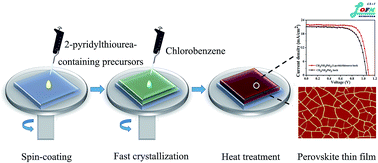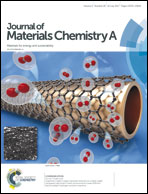Tuning the crystal growth of perovskite thin-films by adding the 2-pyridylthiourea additive for highly efficient and stable solar cells prepared in ambient air†
Abstract
Here, we report a rapid and simple process to prepare perovskite solar cells in ambient air by adding 2-pyridylthiourea in the precursor solution. 2-Pyridylthiourea can not only promote the conversion of 2-D PbI2 to tetragonal CH3NH3PbI3 crystals, but also improve the quality of the perovskite absorber layer via enhancing the uniformity and the size of the crystal grains. The perovskite solar cells with the addition of 2-pyridylthiourea at a concentration of 0.5 mg mL−1 exhibited a remarkable overall power conversion efficiency (PCE) of 18.2%, which is among the highest PCE of CH3NH3PbI3-based devices fabricated in ambient air. It also showed an 18% increase and less hysteresis compared with the cells without additives. Importantly, the devices with 2-pyridylthiourea show relatively better stability compared to reference devices when aged under ambient air of 55 ± 5% relative humidity in the dark and under 65 °C after 30 days. The presented results clearly show that 2-pyridylthiourea can be an additive candidate for tuning the morphology of perovskite thin films, which may be a new direction for large-scale production of PSCs.



 Please wait while we load your content...
Please wait while we load your content...